Experimental Investigation of the Characteristics and Transformation Mechanism of Jimsar Oil Shale and Derived Shale Oil
Abstract
1. Introduction
2. Experimental
2.1. Samples
2.2. Pyrolysis Experiments
2.3. FT-IR Experiments
2.4. Ultimate Analysis
2.5. GC MS Experiments
2.6. NMR Experiments
3. Results and Discussion
3.1. Solid Analysis
3.1.1. 13C NMR Analysis
3.1.2. FT-IR Analysis
3.2. Shale Oil Analysis
3.2.1. Yield of Shale Oil
3.2.2. Ultimate Analysis of Shale Oil
3.2.3. 1H NMR Analysis of Shale Oil
3.2.4. Shale Oil GC-MS Analysis
Effect of Heating Rate on Aliphatics
3.2.5. Effect of Heating Rate on Aromatics
4. Conclusions
Author Contributions
Funding
Data Availability Statement
Acknowledgments
Conflicts of Interest
References
- Baird, Z.S.; Listak, M.; Mozaffari, P.; Oja, V. Vapor pressures of narrow gasoline fractions of oil from industrial retorting of Kukersite oil shale. Oil Shale 2020, 37, 288. [Google Scholar]
- Ding, H.; Ma, Y.; Li, S.; Wang, Q.; Hong, W.; Jiang, H.; Li, H.; Jiang, M. Pyrolytic characteristics of Fushun oil shale and its by-products. J. Therm. Anal. Calorim. 2021, 147, 5255–5267. [Google Scholar] [CrossRef]
- Guo, W.; Yang, Q.; Sun, Y.; Xu, S.; Kang, S.; Lai, C.; Guo, M. Characteristics of low temperature co-current oxidizing pyrolysis of Huadian oil shale. J. Anal. Appl. Pyrolysis 2020, 146, 104759. [Google Scholar] [CrossRef]
- Amer, M.W.; Alhesan, J.S.A.; Marshall, M.; Al-Ayed, O.S.; Awwad, A.M. Low temperature retorting of Jordanian oil shales using semi-continuous apparatus. J. Anal. Appl. Pyrolysis 2019, 142, 104639. [Google Scholar] [CrossRef]
- Hotta, A.; Parkkonen, R.; Hiltunen, M.; Arro, H.; Tiikma, T. Experience of Estonian oil shale combustion based on CFB technology at Narva Power Plants. Oil Shale 2005, 22, 381–397. [Google Scholar] [CrossRef]
- Sidorkin, V.T.; Tugov, A.N.; Vereshchetin, V.A.; Mel’Nikov, D.A. Assessment of combustion of oil shale refinery by-products in a TP-101 boiler. Therm. Eng. 2015, 62, 271–277. [Google Scholar] [CrossRef]
- Kairbekov, Z.K.; Masuda, N.; Ohshima, M.A.; Myltykbaeva, Z.K.; Miura, H. Preliminary Analysis of Oil Shale Obtained from Kalynkara in Kazakhstan. J. Jpn. Pet. Inst. 2014, 57, 192–195. [Google Scholar] [CrossRef]
- Yuan, Z.Y. Comprehensive Utilization of Oil Shale with Analysis of Material Properties. Adv. Mater. Res. 2013, 625, 247–250. [Google Scholar] [CrossRef]
- Amer, M.W.; Alhesan, J.S.A.; Marshall, M.; Awwad, A.M.; Al-Ayed, O.S. Characterization of Jordanian oil shale and variation in oil properties with pyrolysis temperature. J. Anal. Appl. Pyrolysis 2019, 140, 219–226. [Google Scholar] [CrossRef]
- Guo, W.; Zhang, X.; Deng, S.H.; Sun, Y.H.; Han, J.; Bai, F.T.; Kang, S.J.; He, W.T. Enhanced pyrolysis of Huadian oil shale at high temperature in the presence of water and air atmosphere. J. Pet. Sci. Eng. 2022, 215, 110623. [Google Scholar] [CrossRef]
- Wu, Z.H.; Xu, Z.G. Experimental and molecular dynamics investigation on the pyrolysis mechanism of Chang 7 type-II oil shale kerogen. J. Pet. Sci. Eng. 2022, 209, 109878. [Google Scholar] [CrossRef]
- You, Y.; Han, X.; Liu, J.; Jiang, X. Structural characteristics and pyrolysis behaviors of huadian oil shale kerogens using solid-state 13C NMR, Py-GCMS and TG. J. Therm. Anal. Calorim. 2018, 131, 1845–1855. [Google Scholar] [CrossRef]
- Bouamoud, R.; Mulongo-Masamba, R.; El Hamidi, A.; Halim, M.; Arsalane, S. Structural assessments of kerogen-rich oil shale from the Central Kongo formation by solid-state 13C nuclear magnetic resonance and thermal processes. J. Pet. Sci. Eng. 2022, 147, 3483–3494. [Google Scholar] [CrossRef]
- Zou, Y.R.; Sun, J.N.; Li, Z.; Xu, X.Y.; Li, M.W.; Peng, P.A. Evaluating shale oil in the Dongying Depression, Bohai Bay Basin, China, using the oversaturation zone method. J. Pet. Sci. Eng. 2018, 161, 291–301. [Google Scholar] [CrossRef]
- Zhao, S.; Sun, Y.H.; Lu, X.S.; Li, Q. Energy consumption and product release characteristics evaluation of oil shale non-isothermal pyrolysis based on TG-DSC. J. Pet. Sci. Eng. 2020, 187, 106812. [Google Scholar] [CrossRef]
- Xu, Y.; Lun, Z.M.; Pan, Z.J.; Wang, H.T.; Zhou, X.; Zhao, C.P.; Zhang, D.F. Occurrence space and state of shale oil: A review. J. Pet. Sci. Eng. 2022, 211, 110183. [Google Scholar] [CrossRef]
- Yang, D.; Wang, L.; Zhao, Y.S.; Kang, Z.Q. Investigating pilot test of oil shale pyrolysis and oil and gas upgrading by water vapor injection. J. Pet. Sci. Eng. 2021, 196, 108101. [Google Scholar] [CrossRef]
- You, Y.; Han, X.; Wang, X.; Jiang, X. Evolution of gas and shale oil during oil shale kerogen pyrolysis based on structural characteristics. J. Anal. Appl. Pyrolysis 2019, 138, 203–210. [Google Scholar] [CrossRef]
- Wang, Q.; Cui, D.; Wang, P.; Bai, J.; Wang, Z.; Liu, B. A comparison of the structures of >300 °C fractions in six Chinese shale oils obtained from different locations using 1H NMR, 13C NMR and FT-IR analyses. Fuel 2018, 211, 341–352. [Google Scholar] [CrossRef]
- Wang, S.; Liu, J.X.; Jiang, X.M.; Han, X.X.; Tong, J.H. Effect of heating rate on products yield and characteristics of non-condensable gases anf shale oil obtained by retoring dachengzi Oil Shale. Oil Shale 2013, 30, 27–47. [Google Scholar] [CrossRef]
- Al-Harahsheh, A.; Al-Ayed, O.; Al-Harahsheh, M.; Abu-El-Halawah, R. Heating rate effect on fractional yield and composition of oil retorted from El-lajjun oil shale. J. Anal. Appl. Pyrolysis 2010, 89, 239–243. [Google Scholar] [CrossRef]
- Lu, H.; Pan, L.W.; Guo, Y.; Dai, F.Q.; Pei, S.H.; Huang, J.N.; Liu, S. The effect of pyrolysis conditions on the composition of Chinese Jimsar shale oil using FT-IR, 1H-NMR and 13C-NMR techniques. Oil Shale 2022, 39, 37–60. [Google Scholar] [CrossRef]
- Wang, Q.; Ye, J.-b.; Yang, H.-y.; Liu, Q. Chemical Composition and Structural Characteristics of Oil Shales and Their Kerogens Using Fourier Transform Infrared (FTIR) Spectroscopy and Solid-State 13C Nuclear Magnetic Resonance (NMR). Energy Fuels 2016, 30, 6271–6280. [Google Scholar] [CrossRef]
- Tong, J.; Han, X.; Sha, W.; Jiang, X. Evaluation of Structural Characteristics of Huadian Oil Shale Kerogen Using Direct Techniques (Solid-State 13C NMR, XPS, FT-IR, and XRD). Energy Fuels 2011, 25, 4006–4013. [Google Scholar] [CrossRef]
- Solum, M.S.; Mayne, C.L.; Orendt, A.M.; Pugmire, R.J.; Adams, J.; Fletcher, T.H. Characterization of Macromolecular Structure Elements from a Green River Oil Shale, I. Extracts. Energy Fuels 2014, 28, 453–465. [Google Scholar] [CrossRef]
- Fletcher, T.H.; Gillis, R.; Adams, J.; Hall, T.; Mayne, C.L.; Solum, M.S.; Pugmire, R.J. Characterization of Macromolecular Structure Elements from a Green River Oil Shale, II. Characterization of Pyrolysis Products by 13C NMR, GC/MS, and FTIR. Energy Fuels 2014, 28, 2959–2970. [Google Scholar] [CrossRef]
- Yürüm, Y.; Dror, Y.; Levy, M. Effect of acid dissolution on the mineral matrix and organic matter of Zefa EFE oil shale. Fuel Process. Technol. 1985, 11, 71–86. [Google Scholar] [CrossRef]
- Alstadt, K.N.; Katti, D.R.; Katti, K.S. An in situ FTIR step-scan photoacoustic investigation of kerogen and minerals in oil shale. Spectrochim. Acta Part A Mol. Biomol. Spectrosc. 2012, 89, 105–113. [Google Scholar] [CrossRef]
- Washburn, K.E.; Birdwell, J.E. Multivariate analysis of ATR-FTIR spectra for assessment of oil shale organic geochemical properties. Org. Geochem. 2013, 63, 1–7. [Google Scholar] [CrossRef]
- Chen, B.; Han, X.; Jiang, X. In Situ FTIR Analysis of the Evolution of Functional Groups of Oil Shale During Pyrolysis. Energy Fuels 2016, 30, 5611–5616. [Google Scholar] [CrossRef]
- Chen, Y.; Furmann, A.; Mastalerz, M.; Schimmelmann, A. Quantitative analysis of shales by KBr-FTIR and micro-FTIR. Fuel 2014, 116, 538–549. [Google Scholar] [CrossRef]
- Nazzal, J.M. Influence of heating rate on the pyrolysis of Jordan oil shale. J. Anal. Appl. Pyrolysis 2002, 62, 225–238. [Google Scholar] [CrossRef]
- Chi, M.S.; Wang, Q.; Shi, J.X.; Liu, Q.; Cui, D.; Pan, S. 1H Nuclear Magnetic Resonance-Based Chemical Structure Characteristics Analysis of Huadian Shale Oil. Sci. Technol. Eng. 2018, 11, 82–87. (in Chinese). [Google Scholar]
- Huang, Y.-R.; Han, X.X.; Jiang, X.M. Comparison of fast pyrolysis characteristics of Huadian oil shales from different mines using Curie-point pyrolysis-GC/MS. Fuel Process. Technol. 2014, 128, 456–460. [Google Scholar] [CrossRef]
- Huang, Y.; Han, X.; Jiang, X.M. Characterization of Dachengzi Oil Shale fast pyrolysis by Curie-point pyrolysis-GC-MS. Oil Shale 2016, 32, 134. [Google Scholar] [CrossRef]
- Campbell, J.; Koskinas, G.H.; Coburn, T.T.; Stout, N.D. Oil shale retorting—Effects of particle size and heating rate on oil evolution and intraparticle oil degradation. Situ 1977, 2, 1–43. [Google Scholar]
- Campbell, J.H.; Koskinas, G.J.; Gallegos, G.; Gregg, M. Gas evolution during oil shale pyrolysis. 1. Nonisothermal rate measurements. Fuel 1980, 59, 718–726. [Google Scholar] [CrossRef]
- Williams, P.T.; Taylor, D.T. The molecular weight range of pyrolytic oils derived from tyre waste. J. Anal. Appl. Pyrolysis 1994, 29, 111–128. [Google Scholar] [CrossRef]
- Tiwari, P.; Deo, M. Compositional and kinetic analysis of oil shale pyrolysis using TGA–MS. Fuel 2012, 94, 333–341. [Google Scholar] [CrossRef]
- Williams, P.T.; Nazzal, J.M. Polycyclic aromatic compounds in oils derived from the fluidised bed pyrolysis of oil shale. J. Anal. Appl. Pyrolysis 1995, 35, 181–197. [Google Scholar] [CrossRef]
- Burnham, A. Chemistry of Shale Oil Cracking. In Oil Shale, Tar Sands, and Related Materials; American Chemical Society: Washington, DC, USA, 1981; 163.39-60. [Google Scholar]
- Cypres, R. Aromatic hydrocarbons formation during coal pyrolysis. Fuel Process. Technol. 1987, 15, 1–15. [Google Scholar] [CrossRef]
- Fairburn, J.A.; Behie, L.A.; Svrcek, W.Y. Ultrapyrolysis of n-hexadecane in a novel micro-reactor. Fuel 1990, 69, 1537–1545. [Google Scholar] [CrossRef]
- Depeyre, D.; Flicoteaux, C.; Chardaire, C. Pure n-hexadecane thermal steam cracking. Ind. Eng. Chem. Process Des. Dev. 1985, 24, 1251–1258. [Google Scholar] [CrossRef]
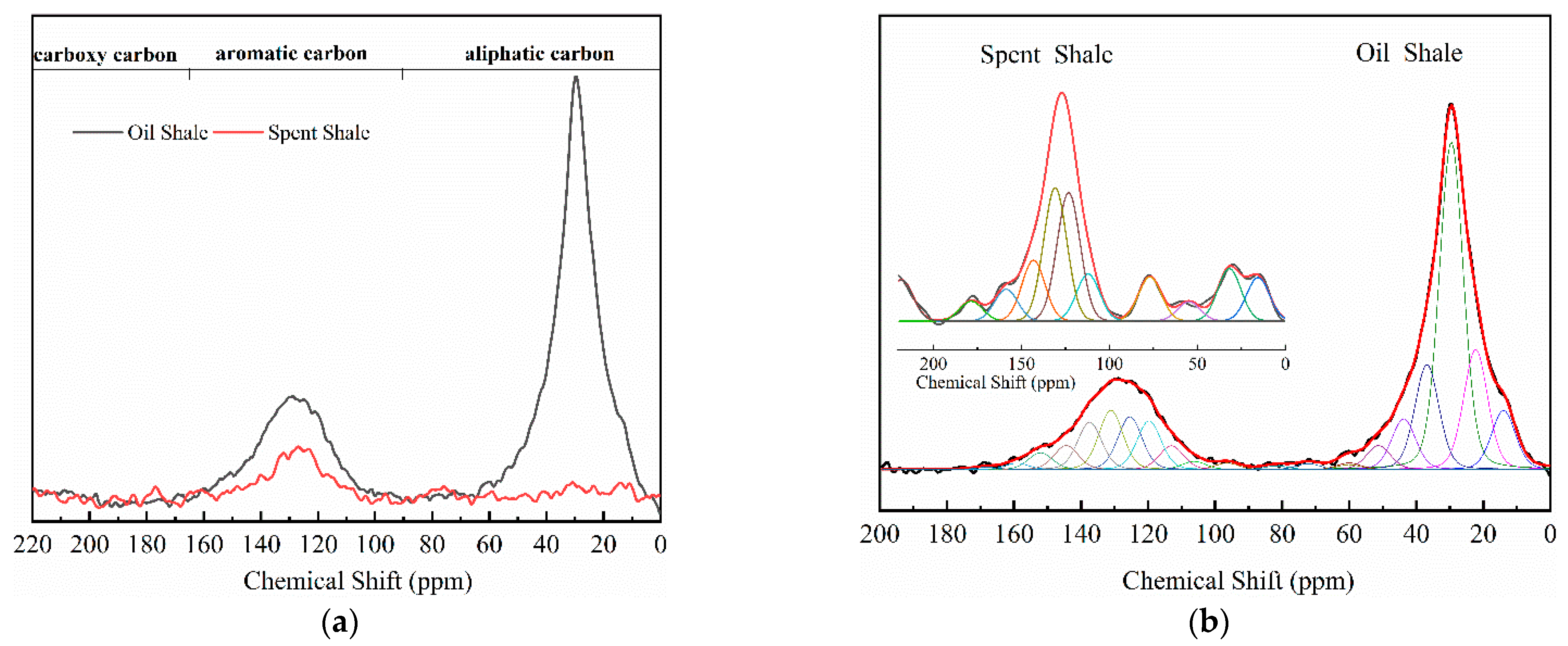


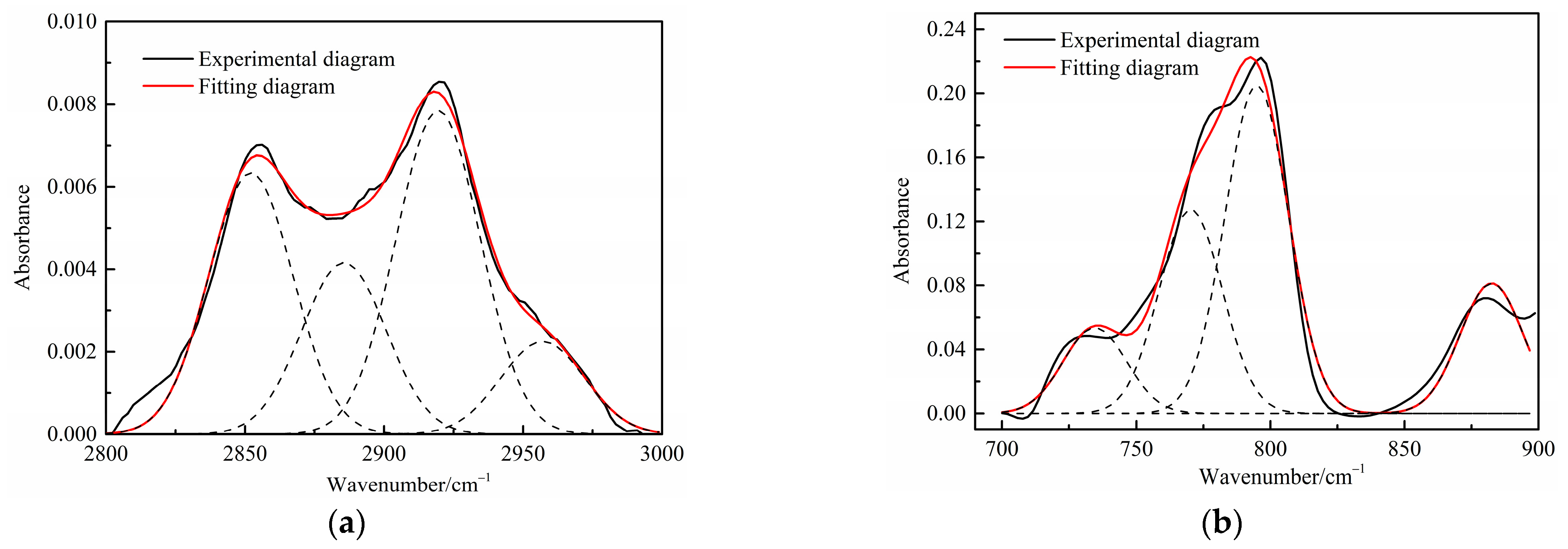


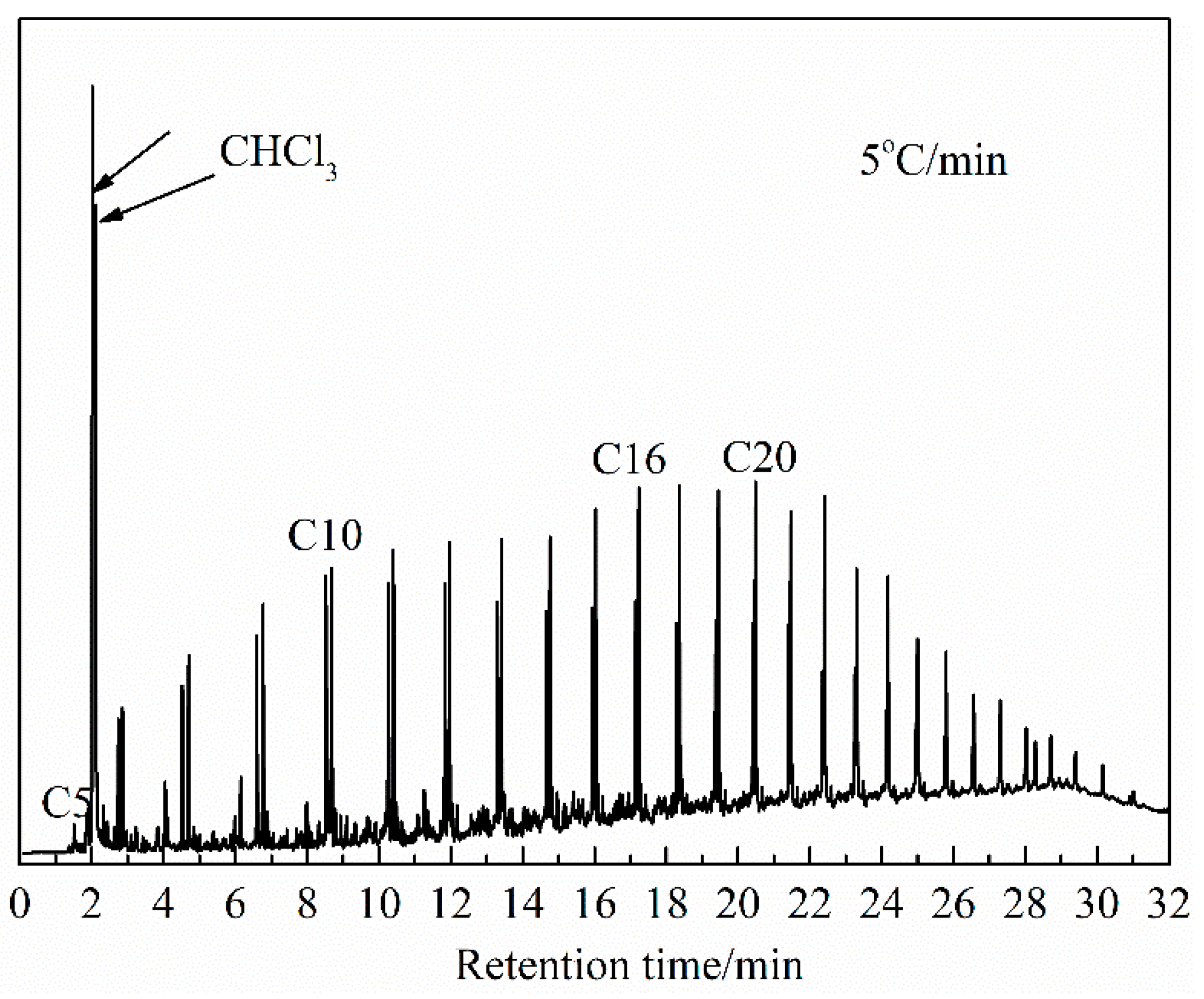
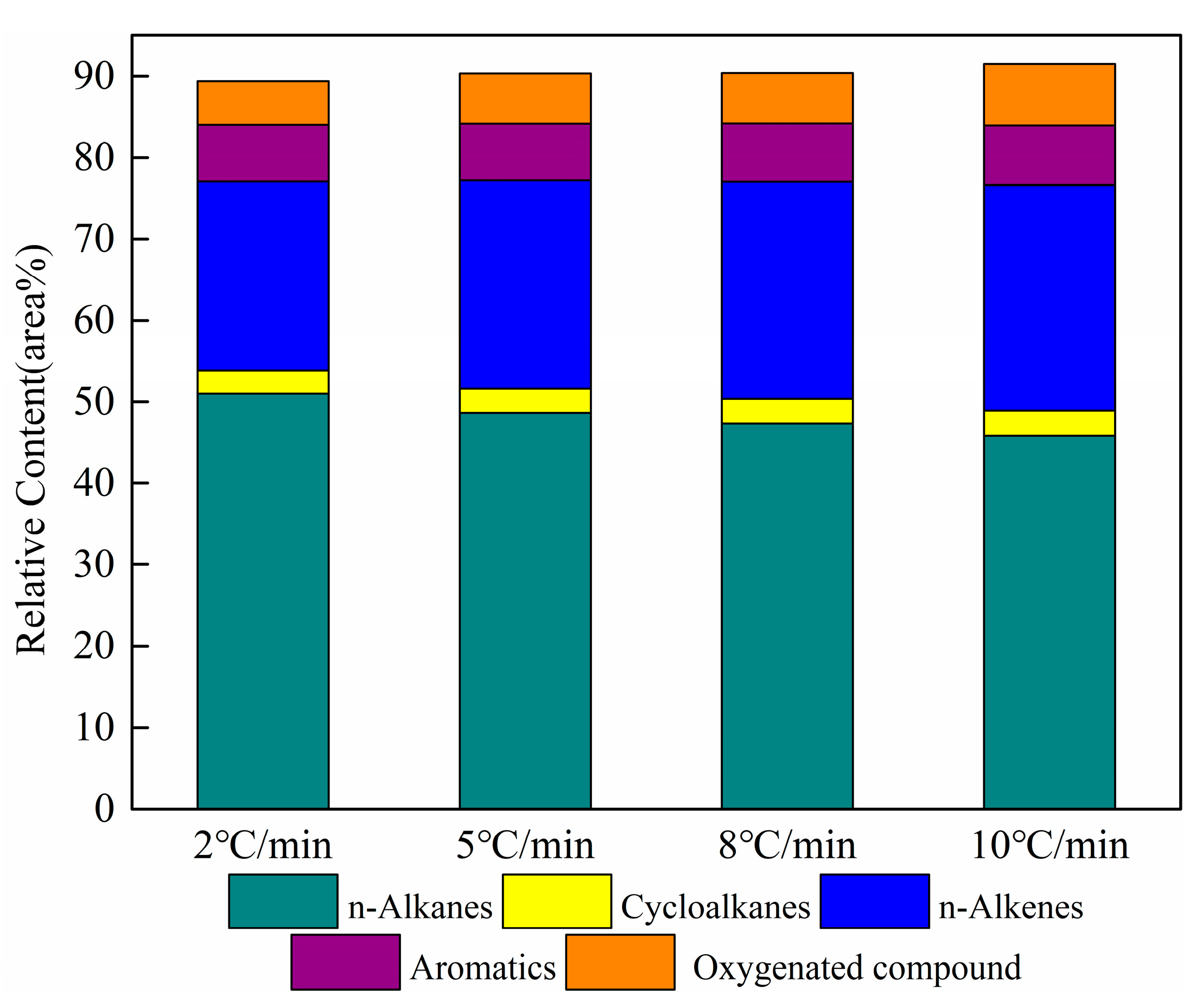
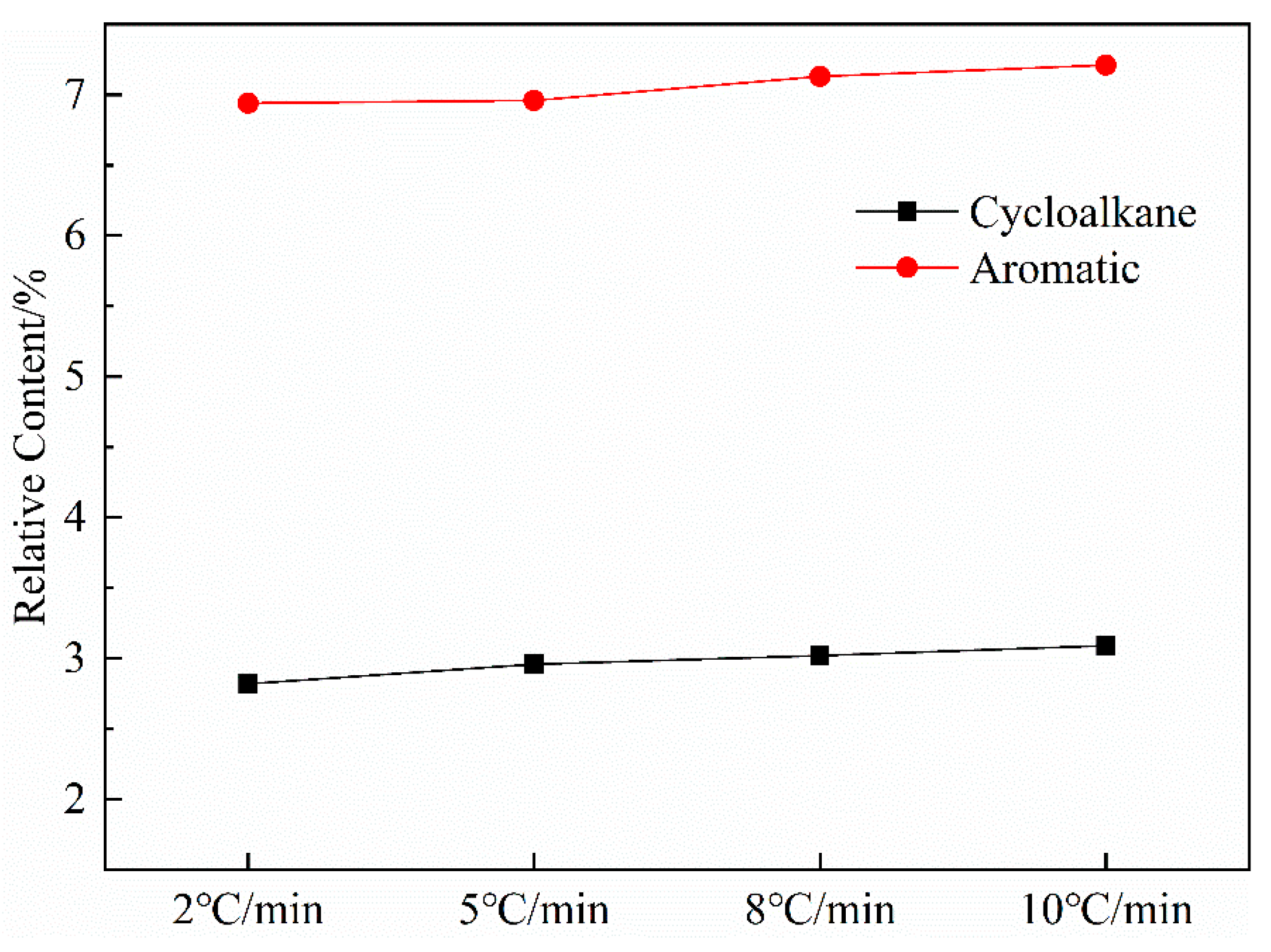
| Proximate analysis | Ash (ad) | 81.12 |
| Volatile matter (ad) | 17.48 | |
| Moisture (ad) | 0.50 | |
| Fixed carbon (ad) | 0.90 | |
| Ultimate analysis | Cd | 11.46 |
| Hd | 1.70 | |
| Od | 8.35 | |
| Nd | 0.61 | |
| Sd | 0.51 |
| Carbon Structure | Carbon Location | Symbol | Chemical Shifts (10−6) | Relative Area (%) | ||||
|---|---|---|---|---|---|---|---|---|
| Oil Shale | Spent Shale (°C/min) | |||||||
| 2 | 5 | 8 | 10 | |||||
| Terminal methyl |  | falA1 | 14–16 | 5.89 | 0 | 0 | 0 | 0 |
| Aromatic methyl |  | falA2 | 16–22 | 0 | 6.89 | 6.9 | 6.47 | 6.03 |
| Methylene |  | falH | 22–36 | 44.61 | 9.52 | 7.93 | 9.37 | 5.88 |
| Methine and Quaternary |  | falD | 36–50 | 15.5 | 0 | 0 | 0 | 0 |
| Oxy-methylene |  | falO1 | 50–60 | 2.39 | 7.78 | 1.95 | 6.2 | 8.1 |
| Oxy-methine |  | falO2 | 60–70 | 1.15 | 0 | 0 | 5.26 | 5.94 |
| Oxy-quaternary |  | falO3 | 70–90 | 0.96 | 7.53 | 8.09 | 3.98 | 2.81 |
| Ortho-oxyaromatic protonated |  | farA | 104–120 | 3.85 | 7.16 | 10.57 | 0 | 6.62 |
| Aromatic protonated |  | farH | 120–129 | 10.12 | 21.01 | 23.25 | 19.95 | 20.67 |
| Bridging aromatic carbon |  | farB | 129–137 | 5.91 | 17.16 | 23.15 | 23.59 | 28.47 |
| Aromatic branched |  | farC | 137–148 | 7.12 | 6.06 | 7.22 | 11.75 | 7.7 |
| Oxy-aromatic carbon |  | farO | 148–165 | 2.31 | 9.9 | 6.34 | 9.32 | 0 |
| Carboxyl and Carbonyl |  | farCC | 165–200 | 0.23 | 6.96 | 4.6 | 4.1 | 7.87 |
| Structural Parameter | Symbol | Formula | Value (%) | ||||
|---|---|---|---|---|---|---|---|
| Oil Shale | Spent Shale (°C/min) | ||||||
| 2 | 5 | 8 | 10 | ||||
| Aliphatic carbon | fal | falA1+ falA2+ falH + falD+ falO1+ falO2+ falO3 | 70.50 | 31.72 | 24.87 | 31.28 | 28.76 |
| Aromatic carbon | far | farA+farH+ farB+ farC+ farO | 29.31 | 61.29 | 70.53 | 64.61 | 63.46 |
| Average chain length | Cn | falH/ farC | 6.27 | 1.57 | 1.10 | 0.80 | 0.76 |
| Substitutive degree of aromatic ring | δ | (farA+ farB+ farC+ farO)/far | 0.65 | 0.66 | 0.67 | 0.69 | 0.67 |
| Number | Position/cm−1 | Assignment | Area Percentage/% | ||||
|---|---|---|---|---|---|---|---|
| Oil Shale | Spent Shale (°C/min) | ||||||
| 2 | 5 | 8 | 10 | ||||
| 1 | 2852–2855 | Symmetric R2CH2 | 27.03 | 28.94 | 30.76 | 26.10 | 29.77 |
| 2 | 2885–2896 | -R2CH | 24.67 | 20.74 | 20.21 | 16.50 | 21.27 |
| 3 | 2920–2922 | Anti-symmetric R2CH2 | 43.83 | 33.16 | 38.11 | 33.49 | 34.48 |
| 4 | 2953–2958 | Anti-symmetric R2CH3 | 13.35 | 17.16 | 10.91 | 23.91 | 14.48 |
| All Area | 6.21 | 0.79 | 0.78 | 0.66 | 0.50 | ||
| Number | Position/cm−1 | Assignment | Area Percentage/% | ||||
|---|---|---|---|---|---|---|---|
| Oil Shale | Spent Shale (°C/min) | ||||||
| 2 | 5 | 8 | 10 | ||||
| 1 | 733–735 | 4H | 13.29 | 9.12 | 11.44 | 13.61 | 9.62 |
| 2 | 754.57 | 3H | 0 | 0.00 | 0.00 | 0.00 | 14.02 |
| 3 | 770–776 | 3H | 30.29 | 25.75 | 27.24 | 30.00 | 31.78 |
| 4 | 794–799 | 3H | 44.53 | 47.67 | 43.92 | 45.55 | 37.67 |
| 5 | 876–884 | 1H | 11.89 | 17.47 | 17.41 | 10.83 | 6.91 |
| All Area | 12.99 | 10.53 | 13.41 | 13.85 | 15.70 | ||
| Element | Heating Rate/°C/min | |||
|---|---|---|---|---|
| 2 | 5 | 8 | 10 | |
| C | 84.06 | 84.70 | 83.78 | 80.21 |
| H | 11.00 | 11.10 | 11.02 | 10.68 |
| O * | 2.53 | 1.60 | 2.75 | 6.74 |
| N | 1.97 | 2.19 | 2.08 | 2.03 |
| S | 0.44 | 0.41 | 0.37 | 0.34 |
| H/C | 1.57 | 1.57 | 1.58 | 1.60 |
| Symbol | Chemical Shift (δ) | Types of Hydrogens | Relative Content/% | |||
|---|---|---|---|---|---|---|
| 2 °C/min | 5 °C/min | 8 °C/min | 10 °C/min | |||
| A | 6.50~9.00 | Aromatic ring proton | 5.91 | 6.09 | 6.58 | 6.67 |
| Id | 7.40~9.00 | Polynuclear aromatics | 1.91 | 2.52 | 2.66 | 2.69 |
| U | 4.50~6.20 | Olefinic proton | 2.90 | 3.19 | 3.32 | 3.53 |
| B | 2.40~3.50 | Aromatic ring α-CH2 alkyl proton | 7.11 | 7.85 | 8.31 | 8.51 |
| C | 2.05~2.40 | Aromatic ring α-CH3 alkyl proton | 4.84 | 5.57 | 6.22 | 6.43 |
| D | 1.60~2.05 | CH2 in cycloalkanes | 8.78 | 9.14 | 8.79 | 8.94 |
| E | 1.40~1.60 | CH2 in cycloalkanes (Removal of CH peaks) | 3.66 | 4.13 | 5.23 | 5.12 |
| F | 1.00~1.40 | Methylene groups of longer alkyl chains | 49.29 | 47.55 | 45.94 | 45.35 |
| G | 0.50~1.00 | CH3 in aromatics, cycloalkanes, alkanes | 15.92 | 14.97 | 14.20 | 14.04 |
| H | 1.40~1.60 | Isomeric alkane CH (10% of the regional G content) | 1.59 | 1.50 | 1.42 | 1.40 |
| Carbon Number | Relative Content (Area%) | |||||||
|---|---|---|---|---|---|---|---|---|
| 2 °C/min | 5 °C/min | 8 °C/min | 10 °C/min | |||||
| n-Alkane | Alkene | n-Alkane | Alkene | n-Alkane | Alkene | n-Alkane | Alkene | |
| C5-C10 | 10.11 | 8.16 | 9.25 | 9.13 | 8.67 | 9.53 | 8.78 | 9.6 |
| C11-C15 | 12.78 | 10.21 | 12.35 | 11.03 | 11.84 | 11.5 | 11.96 | 12.14 |
| C16-C20 | 14.57 | 3.83 | 13.82 | 4.4 | 13.66 | 4.77 | 13.86 | 5.11 |
| C20+ | 13.53 | 1.06 | 13.22 | 1.06 | 13.17 | 0.88 | 11.24 | 0.8 |
| Sum | 50.99 | 23.26 | 48.64 | 25.61 | 47.34 | 26.68 | 45.84 | 27.65 |
| Aliphatic | 74.25 | 74.25 | 74.02 | 73.49 | ||||
Disclaimer/Publisher’s Note: The statements, opinions and data contained in all publications are solely those of the individual author(s) and contributor(s) and not of MDPI and/or the editor(s). MDPI and/or the editor(s) disclaim responsibility for any injury to people or property resulting from any ideas, methods, instructions or products referred to in the content. |
© 2023 by the authors. Licensee MDPI, Basel, Switzerland. This article is an open access article distributed under the terms and conditions of the Creative Commons Attribution (CC BY) license (https://creativecommons.org/licenses/by/4.0/).
Share and Cite
Lu, H.; Pan, L.; Guo, Y.; Xiong, Q.; Dai, F.; Wang, S. Experimental Investigation of the Characteristics and Transformation Mechanism of Jimsar Oil Shale and Derived Shale Oil. Processes 2023, 11, 411. https://doi.org/10.3390/pr11020411
Lu H, Pan L, Guo Y, Xiong Q, Dai F, Wang S. Experimental Investigation of the Characteristics and Transformation Mechanism of Jimsar Oil Shale and Derived Shale Oil. Processes. 2023; 11(2):411. https://doi.org/10.3390/pr11020411
Chicago/Turabian StyleLu, Hao, Luwei Pan, Yue Guo, Quan Xiong, Fangqin Dai, and Shuai Wang. 2023. "Experimental Investigation of the Characteristics and Transformation Mechanism of Jimsar Oil Shale and Derived Shale Oil" Processes 11, no. 2: 411. https://doi.org/10.3390/pr11020411
APA StyleLu, H., Pan, L., Guo, Y., Xiong, Q., Dai, F., & Wang, S. (2023). Experimental Investigation of the Characteristics and Transformation Mechanism of Jimsar Oil Shale and Derived Shale Oil. Processes, 11(2), 411. https://doi.org/10.3390/pr11020411






